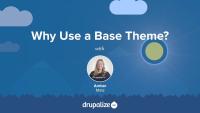In this lesson, we’ll take a look at how to modify the HTML output from Views, explore some of the default templates that Views provides, and learn about the various permutations of names we can give our template files to override output for everything from a large set of Views to a single field on a single View. We’ll also discuss the difference between displays, styles, rows, and fields when it comes to theming a View.
This chapter goes through the process of adding a specific form id to the theme registry with the hook_theme() function, which allows the creation of a new function that targets a specific form. Specifically in this chapter, comment_form is added to the theme registry so that we can create a ninesixtyrobots_comment_form() function in order to add a column to the comment form so that the name and subject fields are displayed side-by-side.
Additional resources
Provides an overview of what is covered in the Theming Basics series and gives a preview of what is yet to be covered within the Advanced Theming video.
In this lesson we're going to learn about the front end development strategy of theming by components. This strategy relies on being able to break a design into individual components. Elsewhere on the Web this technique has been described as “atomic design” or “interface pattern pairing”. No matter what you call it, developing a pattern library of components is going to make it a lot easier to convert your design to a theme. This is an overview lesson that explains the strategy we'll be using in future lessons. More specifically, we'll look at:
- two popular pattern libraries
- an overview of how pages are built by Drupal so they can be rendered in a browser
By the end of this lesson you'll be able to identify components from a static design file by referencing a pattern library.
Additional resources
SMACSS (Scalable and Modular Architecture for CSS)
In this series, we talk about template.php, the file where all your functions live. We’ll also discuss preprocess functions and overriding theming functions. You’ll learn how to create new variables and override existing ones using template.php. With these tools you can allow your theme to have complete control of outputted HTML.
In this video you’ll learn when to use a tpl.php file or your template.php file, and we’ll look at differences between them. We’ll also review the three main steps of theming.
Additional resources
Theming Basics for Drupal 7 will provide a solid foundation for translating designs into Drupal themes. You'll learn to work with .info and tpl.php template files, how to add CSS and JavaScript, how to work with the render system new in Drupal 7, how to override templates, create regions, and use the Theme Developer tool. You'll start with the original HTML, CSS and JavaScript template files that were provided by the designer so that you can follow along in translating the design into a Drupal 7 theme. The video explains Drupal's design vernacular, concepts, and special needs. We'll show you how to associate the proper CSS & Javascript files, add all of the necessary regions, and control the HTML output through page and node-specific templates. You'll learn about the best tools and strategies for controlling the look and feel of your Drupal website.
This series will cover the basics of Drupal theming while the more advanced theming topics of working with the template.php file will be covered in the Advanced Theming for Drupal 7 series. These videos pair with each other, and will finish the complete implementation of the 960 Robots theme used in both videos. You can download the theme we're building from Drupal.org: 960 Robots.
Examples in this video are based on Drupal 7 and its variants.
In this introduction video, we set the stage for the Theming Basics series. We give an overview of what Drupal theming is, the common files we will work with, and the overall steps involved. Then we start off by defining and taking a look at the .info file and HTML template (tpl.php) files. We talk about regions and theme features, introduce the render() function, and explain dynamic templates. While we are teaching Drupal 7 theming, we also make sure to point out the important differences between Drupal 6 and 7.
Additional resources
In this chapter, we'll walk through some of the best practices for filling out a stock Drupal site so that you can start to have some dummy content generated by different users and tagged with different taxonomy tags. We'll step through creating content with the devel generate module, and then do some other site preparation tasks such as creating some menu items and adding a shortcut link to the performance page so that you can quickly access the clear cache button.
Additional resources
This chapter covers some really handy browser extensions in the process of theming. For Firefox, there's the Web Developer Toolbar for turning off and on JavaScript, resizing the browser window to different sizes, and inspecting elements. It also has the capability to test changes to CSS files in a format that is easy to copy and paste into the source file. We also show off the basics of the popular Firebug extension, and the equivalent functionality that is now built in to webkit-based browsers such as Safari and Chrome.
Additional resources
Technically a theme can be installed onto any Drupal site, but it never quite works this way in real life. In this lesson we'll create a playground so that we can try out our theme before deploying it to a live server. We'll start by installing Drupal and adding some “fake” content and menus with the devel generate module. For these tasks we'll use Drupal's default theme, Bartik. By the end of this lesson you will be able to install Drupal in an environment where a development version of the theme can be safely tested.
Additional resources
This learning series covered just the tip of the theming iceberg. Hopefully you're now feeling motivated to learn even more about theming. In this lesson we will review some of the other topics you will want to explore next including: advanced theming techniques, using a base theme, such as Omega, layout modules. By the end of this lesson you will by able to identify which videos you should (or could) watch next to learn more about theming Drupal.
In the next few tutorials, we'll pull back the veil of Views theming a bit and introduce some tools to help you wrangle Views' template files. In this tutorial, I'll introduce you to Views Theme Information and how to use this interface to find out which template files are being used to mark up your view.
Additional resources
PHP for Themers
FreeBefore we dive into advanced theming we are going to review the basic PHP you will need to use. This is a short review of PHP, including topics like data structures (arrays and objects), conditionals and operators, loops, and functions.
Additional resources
This next set of tutorials relates to controlling markup in Drupal when using the Views module. We’ll cover:
- What affects markup in Views
- Selecting an appropriate Views display format as a starting point for markup output
- Customizing field markup
- Customizing wrapper selectors and CSS classes
- Accessing theming information in Views
- Overriding Views template files
Additional resources
Now let's shift gears and take a look at how using Panels affects markup in Drupal. I will show you some unique-to-Panels concepts as well as how to apply Drupal theming principles to customize markup on a Drupal site that uses Panels.
In the tutorials that follow, you will learn:
- About Panels layouts
- How to add CSS classes using Panels
- How to override the panel pane template file
- What Panels means by “Style”—with a broad overview of Style Plugins and where to go for a deeper dive
Additional resources
Panels — Drupal.org
Chaos Tools Suite (CTools) — Drupal.org
Theming Basics for Drupal 7 — Drupalize.Me
Emma Jane Westby introduces the series. In this series, you'll learn how to transform a static design file into a whole Drupal theme. We'll work through three major steps.
- Develop a style guide based on the design patterns we see in our design files.
- Build out Drupal so that it has all of the elements we need in place.
- Work with theming files to decorate Drupal.
Additional Resources
In addition to the lessons in this series, Emma has assembled an extensive FAQ on Drupal theming.
Drupal’s theming system gives designers complete control over how a site’s content is rendered for a web browser, and custom themes can give any site a distinctive look. But sometimes it’s useful to make minor tweaks to a site’s appearance using nothing but CSS rules. They allow designers to tweak font sizes, colors, and so on without altering the underlying HTML that defines the site’s structure. In this lesson we'll look at:
- CSS Injector module
- Explain how this works
Additional resources
Before we can really dive in to learning Omega we need to do a couple of basic setup tasks. Mostly, we need a Drupal 7 site that has some content for us to look at while we are theming. In this lesson we're going to:
- Generate some content with devel generate module
- Install the 960 Robots theme from drupal.org
- Place some blocks in to the regions provided by the 960 Robots theme and talk a bit about what it gives us so that we can begin to understand how we might convert it to an Omega sub-theme
Under the Downloads tab, there is a copy of the final database and the files directory for this Demo site.
Additional resources
Once all of the elements are in place, it's time to get down to the real work of theming the components. In this lesson we will:
- use our style guide and checklist to find each component
- check to see if the style looks "right"
- troubleshoot broken styles so that each component looks as good as the designer's original, static files
By the end of this lesson you will be able to identify elements on a rendered Drupal page which do not have the correct styles applied, determine the source of the problem, and alter the markup or styles to correct the output displayed in a browser.
In this series, Getting Started with Responsive Web Design in Drupal, we'll take an old Drupal theme based on a 960 pixel grid, and convert it, step by step, using just good ole CSS and HTML, to be more fluid, more flexible, more responsive than ever.
Our case study is the Anytown Farmers Markets. Anytown Farmers Markets has an existing web site that uses a theme based on a 960 pixel grid. It works great on larger screens, pretty well on iPads, but on an iPhone, the text is really small and you have to pinch and zoom and horizontally scroll to get around the screen.
Our goal will be to transition the site from a fixed width two column desktop site to a fluid and flexible site whose layout, images, and type gracefully transform at practically any size screen to provide a user-friendly experience where our site's content can be enjoyed by users browsing with a more diverse set of devices.
Throughout this series, you'll learn how to use, configure, and customize the style of a Drupal contributed module that provides a responsive, mobile-friendly main menu. We'll tackle images, tables, and slideshows and explore some select solutions for making these traditionally rigid elements flex with a fluid container. In the process of converting this theme to be responsive, you'll learn to tackle some real-world, sometimes messy and often times not-so-clear-cut problems and potential solutions.
To take advantage of this series, you'll want to be comfortable with HTML and CSS and the basics of setting up a theme in Drupal 7. You don't need to know Sass or any advanced theming. This series will help you understand common problems encountered in responsive web design and how to solve them in the context of a Drupal 7 theme.
Additional resources
In this tutorial, I will explain what a base, or parent, theme is in Drupal and why it can be advantageous to use it in theming. We'll take a look at what is commonly provided by a base theme, including discussing what a "starter kit" is and how it is intended to be used.



















